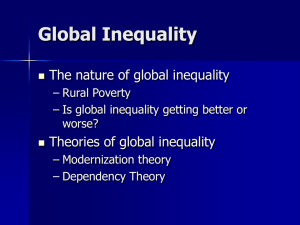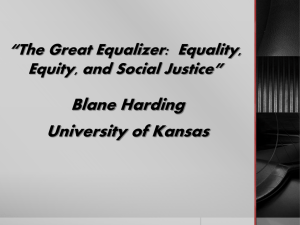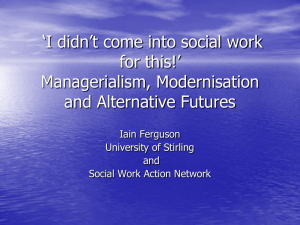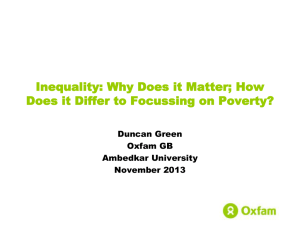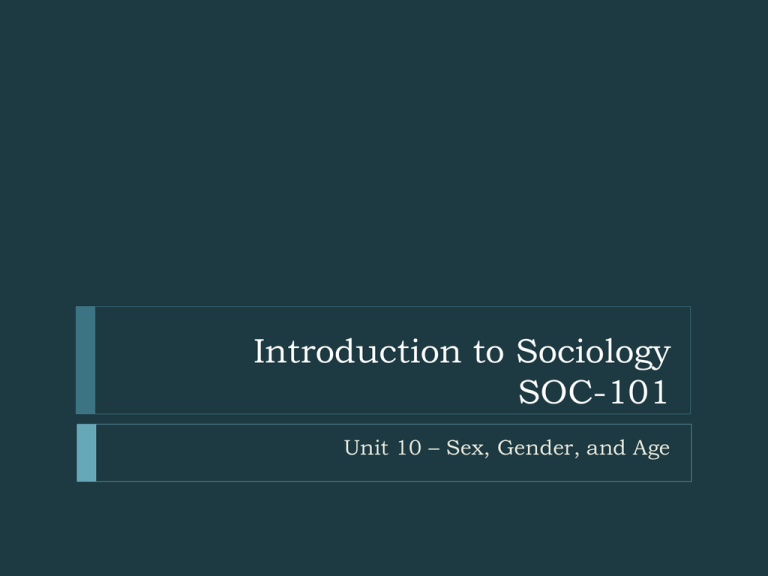
Introduction to Sociology
SOC-101
Unit 10 – Sex, Gender, and Age
Issues of Sex and Gender
Gender stratification refers to the unequal (or differing)
access to power, prestige, and property possessed by men
and by women
Sex and gender reflect different bases for stratification
Sex
Biological characteristics distinguishing males and females
Primary sex organs (organs related to reproduction)
Secondary sex organs (physical distinctions not related to
reproduction)
Issues of Sex and Gender
Gender
A social characteristic, and its impact varies from one society
to another
It refers to the behaviors and attitudes the group considers
proper for its males and females.
The sociological significance of gender is that it serves as
a sorting device by which society controls its members
and thus is a structural feature of society
Issues of Sex and Gender
There is disagreement as to what produces gender
differences in behavior.
Some researchers argue that biological factors (two X
chromosomes in females, one X and one Y in males) result in
differences in the behavior of males (more aggressive and
domineering) and females (more comforting and nurturing)
The dominant sociological position is that gender differences
result from sex being used to mark people for special
treatment
Males and females then take on the relative positions that society
assigns to them
Issues of Sex and Gender
Alice Rossi suggested that women are better prepared
biologically than men for “mothering”
Nature provides biological predispositions that are overlaid
with culture preferences
Medical accidents and studies such as the one involving
Vietnam veterans suggest that the relationship between
biology and social learning is a complex one
Example: one child in 1963 was forced to have a sex change
operation after a botch circumcision burned off his penis
Child was raised as a girl and behaved like a girl
Example: study of Vietnam Veterans showed that men who had
higher testosterone were more aggressive and tend to have
more problems than men with lower levels
Gender Inequality
Gender Inequality
Around the world, gender is the primary division
between people
Every society sets up barriers to deny women equal access
They are therefore referred to as a minority even though they
outnumber men
Although the origin of patriarchy (male dominance) is
unknown, one theory points to the social consequences
of human reproduction
As a result of pregnancy and breast-feeding, women were
limited for much of their lives and they assumed the tasks
associated with the home and child care
Gender Inequality
Men took over those tasks requiring greater speed and longer
absences such as hunting animals
This enabled men to make contact with other tribes and to wage war
Male prestige resulted from their accumulation of possessions
through trade and war with other groups
Little prestige was given to women’s routine tasks, in part because
they were not perceived as risking their lives for the group
Eventually men took over society, using their weapons,
possessions, and knowledge to guarantee that they held more
social power than did women
Gender Inequality
There is no way to test this theory because the answers
lie buried in history
There may be many different causes other than the biology of
human reproduction
Marvin Harris argued that in prehistoric times, each group
was threatened with annihilation by other groups
They had to recruit members to fight enemies in dangerous,
hand-to-hand combat
Bigger and stronger men were coaxed into this bravery by
promises of rewards—sexual access to females
Gender Inequality
Frederick Engels suggested that male dominance
developed in society with the emergence of private
property
However, he did not explain the connection
Today, male dominance is a continuation of millennia-old
patterns
Gender Inequality in the U.S.
Gender Inequality in the U.S.
Women’s rights resulted from a prolonged and bitter
struggle.
U.S. women could not vote, own property, or serve on a
jury until the 20th century
Males did not willingly surrender these privileges, but used
social institutions to maintain their position
Feminism
The view that biology is not destiny and that gender
stratification is wrong and should be resisted
This met with strong opposition
Gender Inequality in the U.S.
The first wave of the women’s movement had a radical
and conservative branches
The second wave began in the 1960s
Radicals wanted to reform all social institutions
Conservative branch concentrated on winning the vote for
women and thus dominated
Both branches of the movement more or less disappeared
after suffrage was achieved
Its goals ranged from changing women’s work roles to changing
policies on violence against women
While women enjoy more rights today, gender inequality
still exists
Gender Inequality in the U.S.
Researchers have found sex discrimination in the area of
medicine and health care
Physicians sometimes dismiss the complaints of female patients
as not serious
This neglect could be a matter of life and death
One example is in the area of diagnosing and treating heart disease
Physicians regard women’s reproductive organs as “potentially
disease producing” and largely unnecessary after childbearing
years
They frequently recommend their removal
Surgeons make a lot of money from the unnecessary removal of these
organs
Gender Inequality in the U.S.
Despite evidence of the educational gains made by
women some traditionally male-female distinctions persist
In college, males and females are channeled into different fields
The proportion of females decreases in postgraduate work,
though this too is slowly changing
There is also gender stratification in both the rank and pay
within higher educational institutions.
90% of library science associate degrees are awarded to females
95% percent of associate degrees in construction trades are awarded
to males
Women at all levels are paid less than their male counterparts
Changes are taking place
The proportion of professional degrees earned by women has
increased in recent years
Changes in College Enrollment by Sex
Gender Inequality in the U.S.
There have been significant changes in the workforce as
the number of working women has increased
However, discrimination against women is still very visible
In 1900, one in five workers was female; today it is almost one
in two
Women who work full-time average only 72 percent of what
men are paid despite their level of educational achievement
This is true even when they have more qualifications than their male
counterparts
Half of this pay gap results from women entering the work force in
lower-paying jobs
Gender Inequality in the U.S.
The “glass ceiling” describes an invisible barrier that
women face in the work force
Men, who dominate the executive suites, stereotype potential
leaders as people who look like themselves
In addition, women lack mentors as male executives are
reluctant to get close to female subordinates because they fear
gossip and sexual harassment charges, or they believe that
women are weak
In recent years women who are highly motivated, fiercely
competitive, and play by “men’s rules,” have begun to crack the
glass ceiling
Gender Inequality in the U.S.
Until the 1970s, women did not draw a connection
between unwanted sexual advances on the job and their
subordinate positions at work
But as women began to discuss the problem, they named it and
came to see unwanted sexual advances by men in powerful
positions as a structural problem
The change resulted from reinterpreting women’s experiences
and giving them a name
Gender Inequality in the U.S.
As more women move into positions of authority over
men, the problem of sexual harassment is no longer
exclusively a female problem
Ongoing court cases have resulted in changes as to what
is and is not included within the legal definition of sexual
harassment
The Court has ruled that sexual harassment laws also apply to
homosexuals who are harassed by heterosexuals on the job
Gender Inequality in the U.S.
Women are more likely to be victims of violence than
men
Every year in the United States, 0.59 of every 10,000
females is raped
The typical rapist is under the age of 30
Of increased concern today is the widespread incidence of
date rape
Studies show that only 5 percept of date rape cases at universities are
reported
Males are more likely to commit murder than females,
and males commit 89 percent of the murders involving
women victims
Gender Inequality in the U.S.
Women are also disproportionate victims of family
violence and of genital circumcision
Feminists use symbolic interactionism to understand
violence against women
They stress that U.S. culture promotes violence by males as it
teaches men to associate power, dominance, strength, virility,
and superiority with masculinity
Men use violence in an attempt to maintain a higher status
To solve violence we must first break the link between
violence and masculinity
Could be done through educational programs in schools,
churches, homes, and the media
Changing Face
of Politics
The Changing Face of Politics
Despite the gains U.S. women have made in recent
elections, they continue to be underrepresented in
political office, especially in higher office
Trends from the 1990s indicated that women participated
in political life in greater numbers than in the past
Indicators that things will change include:
More women going into careers in law and business
Traveling and establishing wider networks of support
Fact that child care is increasingly seen as the mutual responsibility of
both parents
The Changing Face of Politics
As women play a more full role in society, the structural
obstacles to women’s participation will give way
Relationships between men and women will change and some
of the distinctions between the sexes will disappear
The goal is greater appreciation of sexual differences coupled
with increased equality of opportunity
Aging
Aging in Global Perspective
Every society must deal with the process of people aging
The Tiwi (Australia) have a custom of “covering up” aged
women who have become too feeble to look after
themselves
They dig a hole, place the elderly woman in it, cover her body
with dirt, and leave her to die
In their culture, when the woman is later found dead, it is from
natural causes—she has died because she is too old and frail to
dig herself out of the hole and survive
Aging in Global Perspective
In Abkhasia (Caucasus region), the people commonly live
to be 100, or even older
Possible reasons for their longevity include:
Diet and eating customs (overeating is considered dangerous)
Lifelong physical activity (they don’t begin to slow down until age 80)
Social integration (the elderly are active, valued, contributing members
of the society, never isolated from family and community)
This reveals an important sociological principle
Aging is socially constructed
Attitudes towards aging are rooted in society and therefore
differ from one social group to the next
Aging in Global Perspective
In industrialized nations, life expectancy increases because
of a more plentiful food supply, a safer water supply, and
the control of certain diseases
As the elderly population increases, so does the cost of
meeting their particular needs
This has become a major social issue in the Most Industrialized
Nations as the young members face a growing tax burden to pay for
benefits to the elderly
In the Least Industrialized Nations, there are no social security
taxes and families are expected to take care of their own
elderly
Aging in Global Perspective
The graying of America refers to the proportion of older
persons in the U.S. population
Almost 13 percent of the population has achieved age 65
The maximum length of life, the life span, has not increased
Theoretical
Perspectives on
Aging
The Symbolic Interactionist Perspective
Robert Butler coined the term “ageism” to refer to
prejudice, discrimination, and hostility directed at people
because of their age
In U.S. society today, the general image of old age is
negative, but researchers have found that at one time, old
age had some positive meanings
Few made it to old age, so those who did were respected
In the days before Social Security provided for retirement, the
elderly worked and were seen as wise and knowledgeable
about work skills
The Symbolic Interactionist Perspective
Industrialization eroded traditional bases of respect
With improved sanitation and health care, living to an old age
was no longer unique
The mystique that the elderly possess superior knowledge was
stripped away by mass education
The aging baby boom generation, because of their
numbers and their better financial standing, will very likely
contribute to more positive symbols of aging
The Functionalist Perspective
Functionalists examine age from the standpoint of how
those persons who are retiring and those who will
replace them in the work force make mutual adjustments
Elaine Cumming and William Henry developed
disengagement theory to explain how society prevents
disruption to that society when the elderly retire
The elderly are rewarded (pensions) for giving up positions
rather than waiting until they become incompetent or die
This allows for a smooth transition of positions
This is criticized because it assumes that the elderly disengage
and then sink into oblivion
The Functionalist Perspective
Activity theory
Examines people’s reactions to this exchange of one set of
roles for another
Older people who maintain a high level of activity tend to be
more satisfied with life than those who do not
Level of activity is connected to key factors such as social class,
health, and individual orientation
The Conflict Perspective
Conflict theorists examine social life as a struggle
between groups for scarce resources
Social Security legislation is an example of that struggle
In the 1920s–30s, two-thirds of all citizens in the United
States over 65 had no savings and could not support
themselves
Francis Townsend enrolled one-third of all Americans over 65
in clubs that sought a national sales tax to finance a monthly
pension for all Americans over age 65
To avoid the plan without appearing to be opposed to old-age
pensions, an alternative, Social Security, was enacted by
Congress
The Conflict Perspective
Conflict theorists state that Social Security was not a
result of generosity, but rather of competition among
interest groups
Since equilibrium is only a temporary balancing of social
forces, some form of continuing conflict between the
young and the old appears inevitable
The huge costs of Social Security have become a national
concern
One out of every four tax dollars goes to support the Social
Security and Medicare programs
The Conflict Perspective
Some argue that the needs of the elderly and of children
are on a collision course
Data indicate that as the number of elderly poor decreases, the
number of children in poverty increases
It has been argued that the comparison is misleading because
the money that went to the elderly did not come from money
intended for the children
Framing the issue in this way is an attempt to divide the
working class, and to force a choice between the needs of
children and those of the elderly
The “Greying” of America



